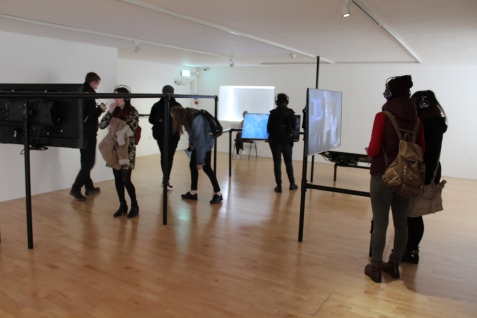 “I think that the very great artists were not trying to express themselves.They were trying to trap the fact, because after all, artists are obsessed by life and by certain things that obsess them that they want to record. And they’ve tried to find systems and construct the cages in which these things can be caught.” – Francis Bacon, Tate Liverpool ‘Invisible Rooms’ exhibition catalogue
“I think that the very great artists were not trying to express themselves.They were trying to trap the fact, because after all, artists are obsessed by life and by certain things that obsess them that they want to record. And they’ve tried to find systems and construct the cages in which these things can be caught.” – Francis Bacon, Tate Liverpool ‘Invisible Rooms’ exhibition catalogue
I read this quote last night and it has stuck with me as I tried to grapple with Bacon’s analysis in relation to my own work. In my view he is absolutely right, artists are obsessed with life; whether it is the architecture we live in, our own bodies, nature and the natural environment, urbanism, industrialism, consumerism. You name it. We’ve made art about everything. Art in a sense could almost be compared to science. It is a route to discovery, a journey of experimentation and deduction. Much like scientists employing mathematics in an attempt to predict the movements of particles, artists engage with their surroundings and various mediums in an attempt to express themselves and their ideas. Conceptual art is at the forefront of modern art today, as by utilizing artworks as tools we are able to realise an idea and convey it to a public audience. Yet there is also and will always be the most expressive form of art; art that does not require proposals and adherences to restricted budget costs, art that does not require a white cube gallery space to be displayed in, but art that simply is from the self. Raw, unaltered sketches, drawings, illustrations and doodles. The purest form of expression and that emotional/creative release.

Doodling culture and the professional art world have more in common than most people initially think as they are both incredibly different, yet simultaneously the same. Yes, in galleries there are large scale installations and elaborate industrial sculptures Jeff Koons style, but it all began in the artist’s mind. It quite likely originated with a little paper doodle or a frantic sketch on a table napkin at the crucial moment of realising the sketchbook was left on the coffee table at home. I feel in a lot of cases there are too many barriers between ‘high’ and ‘low’ art forms, too many words that separate what is classified as good and not so good work. Of course, personal taste and style plays a vital part in these judgements as negotiating personal opinion is one of art’s main experiments; to make people question, to challenge them into realising what it is they do and don’t like is at the core of several artistic practices. In a lot of cases however it is the observers who validate what qualifies as good and bad artwork, who make the official distinction which everyone should follow.

Like anything else in this world, people are happy to follow trends. Whether that is reading a book that everyone else is reading, engaging with an artist who everyone is talking about, visiting an exhibition that everyone else has seen. Despite the creation of artwork being one of the purest forms of human expression and the most individual and personal entity in human existence, art is still not exempt from the trap of following what is considered mainstream. In a sense however, this actually makes it more interesting as you could ask the question who do we make art for? In this day and age, with the pace of social media and the digital information we are constantly fed, there is a heightened sense of expectation in artmaking and inevitably, artists react to this. So who do artists actually make art for? Is it purely for themselves as the most raw forms of self expression? Is it for an art based audience who will engage with it in the way that the artist themself has? Or is it for a public audience, whose art background and knowledge is probably sparse? Or does it fall within all of these categories? It’s interesting as in a lot of cases I would say it is a combination. You often make art for different purposes which include selling, giving as presents and so these distinctions in themselves also affect the purpose and thinking surrounding the making of the piece.

I’m not criticising any of these modes of artmaking. I think art is personal and the purpose of the artwork extends within that personal realm. Each person is different, as is each artwork and artist. I know that my artwork varies a lot of the time depending on audience, how I’m feeling, whether it’s for myself or for display. Given that traditionally and throughout human history art has been hung on the wall in Salons and grand entrance halls for all people to see, it is ironic that my art is actually very private. My doodles are my ‘me time’ turned into physical forms. I find it soothing to get lost in a swirling world of colour and fine lines as I carefully navigate across the page. My performances are less concentrated and more physical expressions of my innermost thoughts which can only be conveyed and released through this immersive and bodily art form. I think the reason Bacon’s quote caught me was because I myself can relate to it quite strongly. Although it is not always a conscious decision, life is fundamentally a core part of my artwork. As Eva Hesse once said “my inner soul art and life are inseparable”.





